Establishment of Intrinsic Permeability of Coarse Open-Graded Materials: Review and Analysis of Existing Data from Natural Air Convection Tests
Abstract
1. Introduction
2. Natural Air Convection in Porous Media
2.1. Natural Air Convection
2.2. Effective Thermal Conductivity
2.3. Intrinsic Permeability
3. A Method for Determining the Intrinsic Permeability from Natural Air Convection Tests
4. Large-Scale Laboratory Experiments
4.1. Experiments by Johansen (1975)
4.2. Experiments by the Norwegian Geotechnical Institute (NGI)
4.3. Experiments by Côté et al. (2011)
4.4. Experiments by Rieksts et al. (2017)
4.5. Summary of Experimental Setup Overviewed
5. Establishment of Intrinsic Permeability from Experimental Convection Results
5.1. Study by Côté et al. (2011)
5.2. Reanalysis of Johansen’s (1975) Data by Côté et al. (2011)
5.3. Studies by Rieksts et al. (2017, 2020)
5.4. Reanalysis of Experimental Data by NGI (1999) and Goering et al. (2000)
6. Discussion
6.1. Effect of Particle Gradation
6.2. Intrinsic Permeability
6.3. Possible Discrepancies in NGI Data
7. Conclusions
Funding
Conflicts of Interest
References
- Farouki, O.T. Thermal Properties of Soils; CRREL Monograph 81-1; US Army Corps of Engineering, Cold Regions Research and Engineering Laboratory: Hanover, NH, USA, 1981. [Google Scholar]
- Johansen, O. Thermal Conductivity of Soils. Ph.D. Thesis, University of Trondheim, Trondheim, Norway, 1975. US Army Corps of Engineering, Cold Regions Research and Engineering Laboratory, Hanover. N.H. CRREL Draft English Translation 637.291. [Google Scholar]
- Goering, D.J. Experimental investigation of air convection embankments for permafrost-resistant roadway design. In Proceedings of the Seventh International Conference on Permafrost, Yellowknife, Northwest Territories, NWT, Canada, 23–27 June 1998; pp. 319–326. [Google Scholar]
- Goering, D.J.; Instanes, A.; Knudsen, S. Convective heat transfer in railway embankment ballast. In Proceedings of the International Symposium on Ground Freezing and Frost Action in Soils, Ground Freezing 2000: Frost Action in Soils, Louvan-la-Neuve, Belgium, 11–13 September 2000; pp. 31–36. [Google Scholar]
- Goering, D.J. Passively Cooled Railway Embankments for Use in Permafrost Areas. J. Cold Reg. Eng. 2003, 17, 119–133. [Google Scholar] [CrossRef]
- Côté, J.; Fillion, M.-H.; Konrad, J.-M. Intrinsic permeability of materials ranging from sand to rock-fill using natural air convection tests. Can. Geotech. J. 2011, 48, 679–690. [Google Scholar] [CrossRef]
- Fillion, M.-H.; Côté, J.; Konrad, J.-M. Thermal radiation and conduction properties of materials ranging from sand to rock-fill. Can. Geotech. J. 2011, 48, 532–542. [Google Scholar] [CrossRef]
- Nield, D.A.; Bejan, A. Convection in Porous Media; Springer: Berlin/Heidelberg, Germany, 2013; p. 778. [Google Scholar]
- Schubert, G.; Straus, J.M. Three-dimensional and multicellular steady and unsteady convection in fluid-saturated porous media at high Rayleigh numbers. J. Fluid Mech. 1979, 94, 25–38. [Google Scholar] [CrossRef]
- Straus, J.M. Large amplitude convection in porous media. J. Fluid Mech. 1974, 64, 51–63. [Google Scholar] [CrossRef]
- Straus, J.M.; Schubert, G. On the existence of three-dimensional convection in a rectangular box containing fluid-saturated porous material. J. Fluid Mech. 1978, 87, 385–394. [Google Scholar] [CrossRef]
- Côté, J.; Konrad, J.-M. Assessment of structure effects on the thermal conductivity of two-phase porous geomaterials. Int. J. Heat Mass Transf. 2009, 52, 796–804. [Google Scholar] [CrossRef]
- Howell, J.R.; Menguc, M.P.; Siegel, R. Thermal Radiation Heat Transfer; CRC Press: Boca Raton, FL, USA, 2010. [Google Scholar]
- Xue, S.C.; Poladian, L.; Barton, G.W.; Large, M.C.J. Radiative heat transfer in preforms for microstructured optical fibres. Int. J. Heat Mass Transf. 2007, 50, 1569–1576. [Google Scholar] [CrossRef]
- Tien, C.L. Thermal Radiation in Packed and Fluidized Beds. J. Heat Transf. 1988, 110, 1230–1242. [Google Scholar] [CrossRef]
- Argo, W.; Smith, J. Heat transfer in packed beds-prediction of radial rates in gas-solid beds. Chem. Eng. Prog. 1953, 49, 443–451. [Google Scholar]
- Dudgeon, C.R. An experimental study of the flow of water through coarse granular media. La Houille Blanche 1966, 7, 785–801. [Google Scholar] [CrossRef]
- Carman, P.C. Flow of Gases through Porous Media; Academic Press: Cambridge, MA, USA, 1956. [Google Scholar]
- Kozeny, J. Ueber kapillare Leitung des Wassers im Boden. Sitz. Wien. Akad. 1927, 136, 271–306. [Google Scholar]
- Chapuis, R.P. Predicting the saturated hydraulic conductivity of sand and gravel using effective diameter and void ratio. Can. Geotech. J. 2004, 41, 787–795. [Google Scholar] [CrossRef]
- NGI. Måling av Varmetap i Ulike Steinfyllingsfraksjoner. Måling av Varmetap i Ballastpukk, Maskinkult og Sprengstein; Norges Geotekniske Institutt (Norwegian Geotechnical Institute): Oslo, Norway, 1999; p. 35. [Google Scholar]
- Combarnous, M.A.; Bories, S.A. Hydrothermal Convection in Saturated Porous Media. Adv. Hydrosci. 1975, 10, 231–307. [Google Scholar] [CrossRef]
- Elder, J.W. Steady free convection in a porous medium heated from below. J. Fluid Mech. 1967, 27, 29–48. [Google Scholar] [CrossRef]
- Kaneko, T.; Mohtadi, M.; Aziz, K. An experimental study of natural convection in inclined porous media. Int. J. Heat Mass Transf. 1974, 17, 485–496. [Google Scholar] [CrossRef]
- Yen, Y.-C. Effects of density inversion on free convective heat transfer in porous layer heated from below. Int. J. Heat Mass Transf. 1974, 17, 1349–1356. [Google Scholar] [CrossRef]
- Côté, J.; Fillion, M.-H.; Konrad, J.-M. Corrigendum: Intrinsic permeability of materials ranging from sand to rock-fill using natural air convection tests. Can. Geotech. J. 2011, 48, 1149. [Google Scholar] [CrossRef]
- Rieksts, K.; Hoff, I.; Kuznetsova, E.; Côté, J. Laboratory investigations on heat transfer of coarse crushed rock materials. In Proceedings of the 70th Canadian Geotechnical Conference and the 12th Joint CGS/IAH-CNC Groundwater Conference, Ottawa, ON, Canada, 1–4 October 2017. [Google Scholar]
- NGI. Måling av Varmeledningsevne i Springstein. Ufrosset Varmeledningstall for Stein i Fraksjon 0–100 mm og 0–250 mm; Norges Geotekniske Institutt (Norwegian Geotechnical Institute): Oslo, Norway, 1996; p. 16. [Google Scholar]
- NGI. Måling av Varmeledningsevne i Springstein. Ufrosset Varmeledningstall for Stein i Fraksjon 20–250 mm; Norges Geotekniske Institutt (Norwegian Geotechnical Institute): Oslo, Norway, 1996; p. 20. [Google Scholar]
- NGI. Måling av Varmeledningsevne i Springstein. Ufrosset Varmeledningstall for Stein i Fraksjon 20–250 mm, jordfuktig tilstand; Norges Geotekniske Institutt (Norwegian Geotechnical Institute): Oslo, Norway, 1996; p. 20. [Google Scholar]
- Rieksts, K.; Hoff, I.; Kuznetsova, E.; Côté, J. Laboratory investigations into convective heat transfer in road construction materials. Can. Geotech. J. 2020, 57, 959–973. [Google Scholar] [CrossRef]
- Côté, J.; Fillion, M.-H.; Konrad, J.-M. Estimating Hydraulic and Thermal Conductivities of Crushed Granite Using Porosity and Equivalent Particle Size. J. Geotech. Geoenviron. Eng. 2011, 137, 834–842. [Google Scholar] [CrossRef]
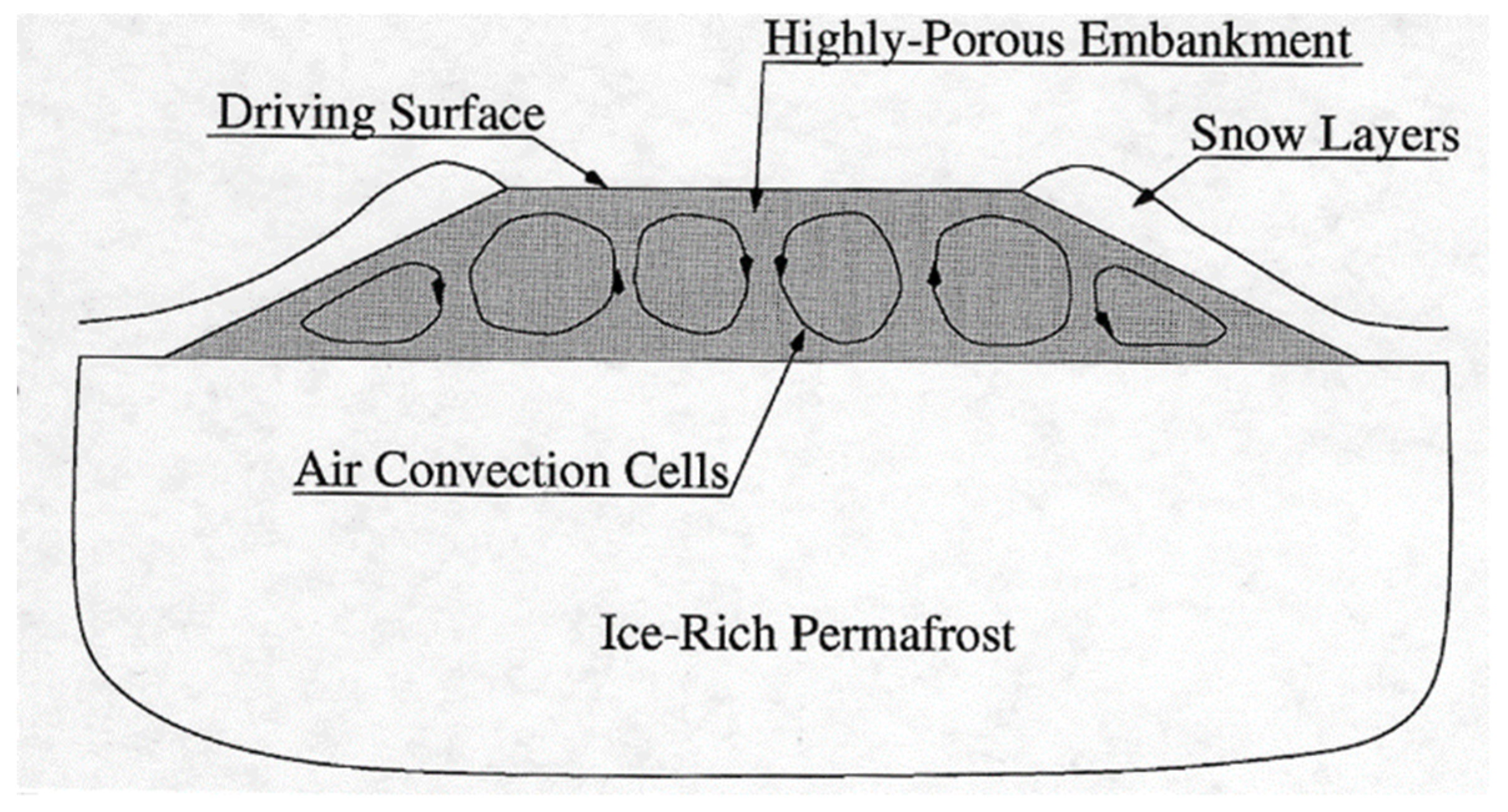
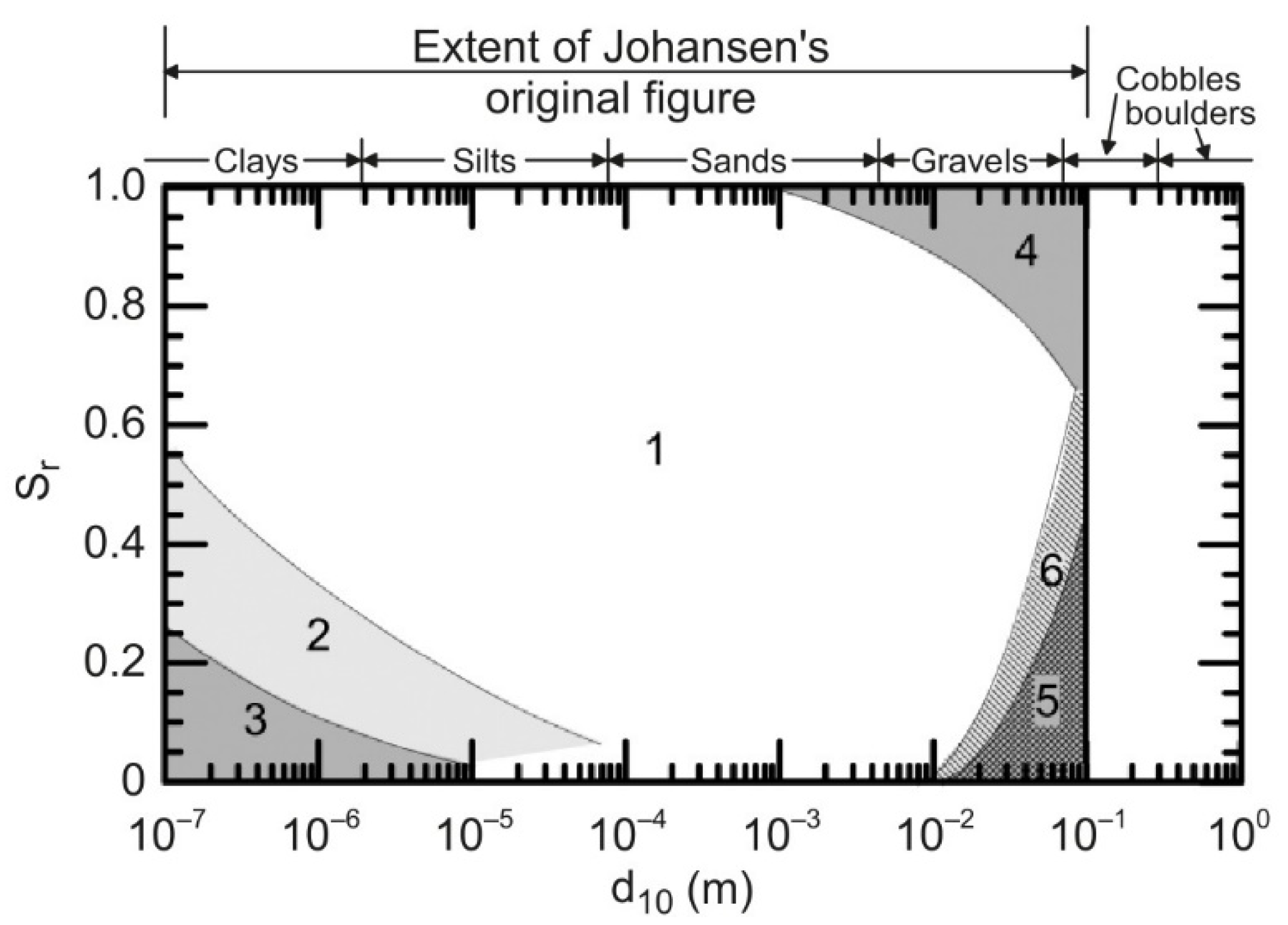
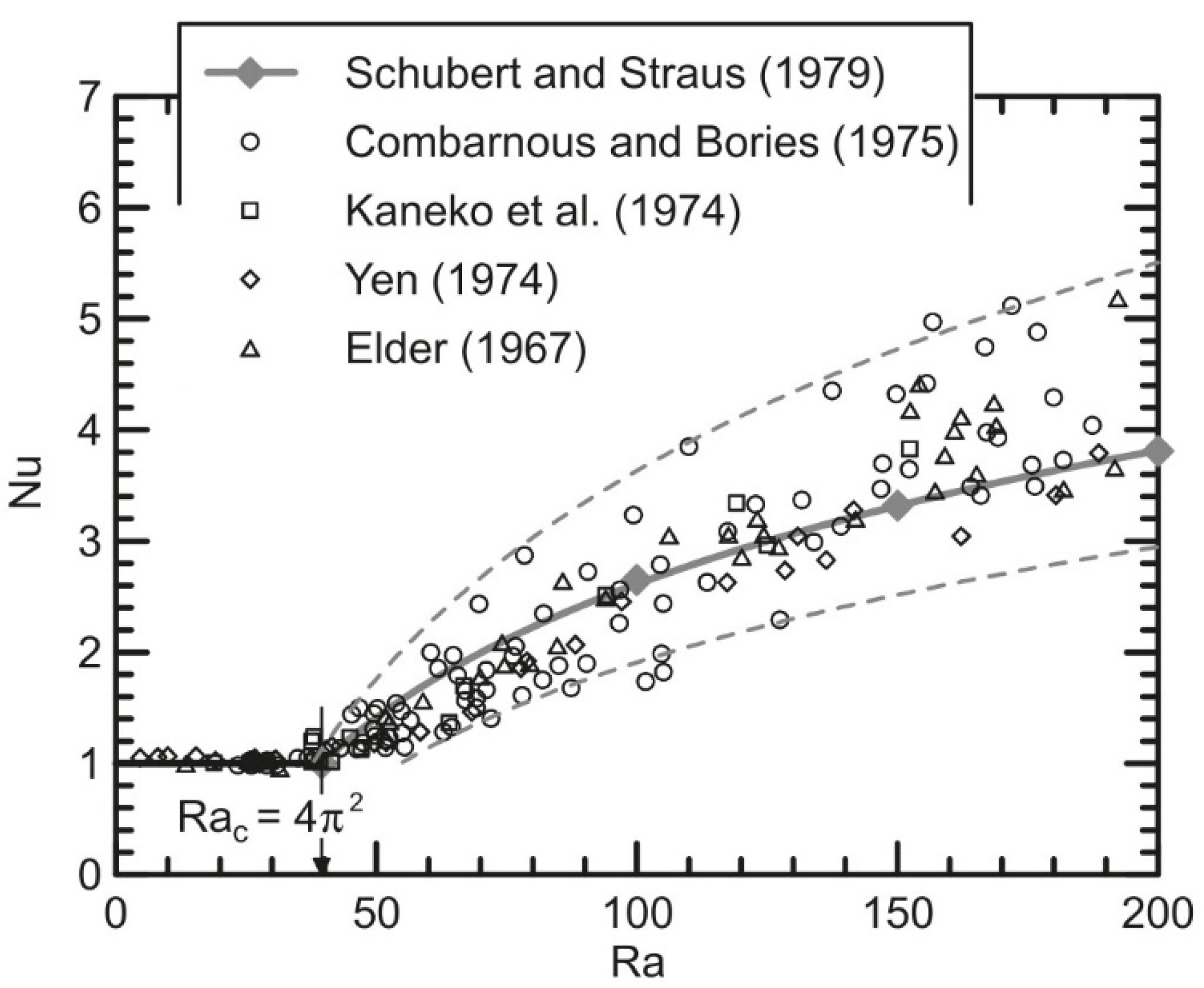
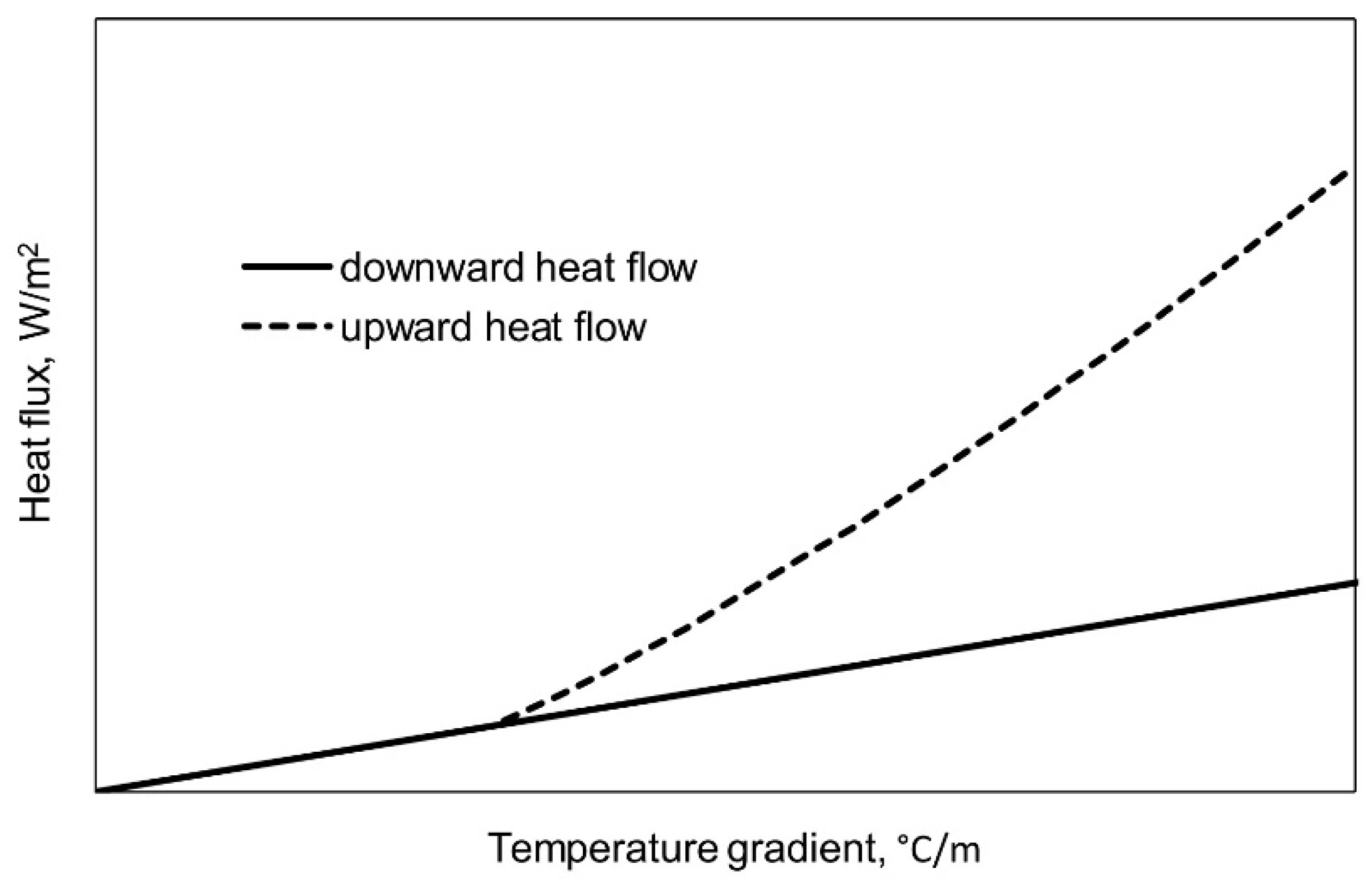


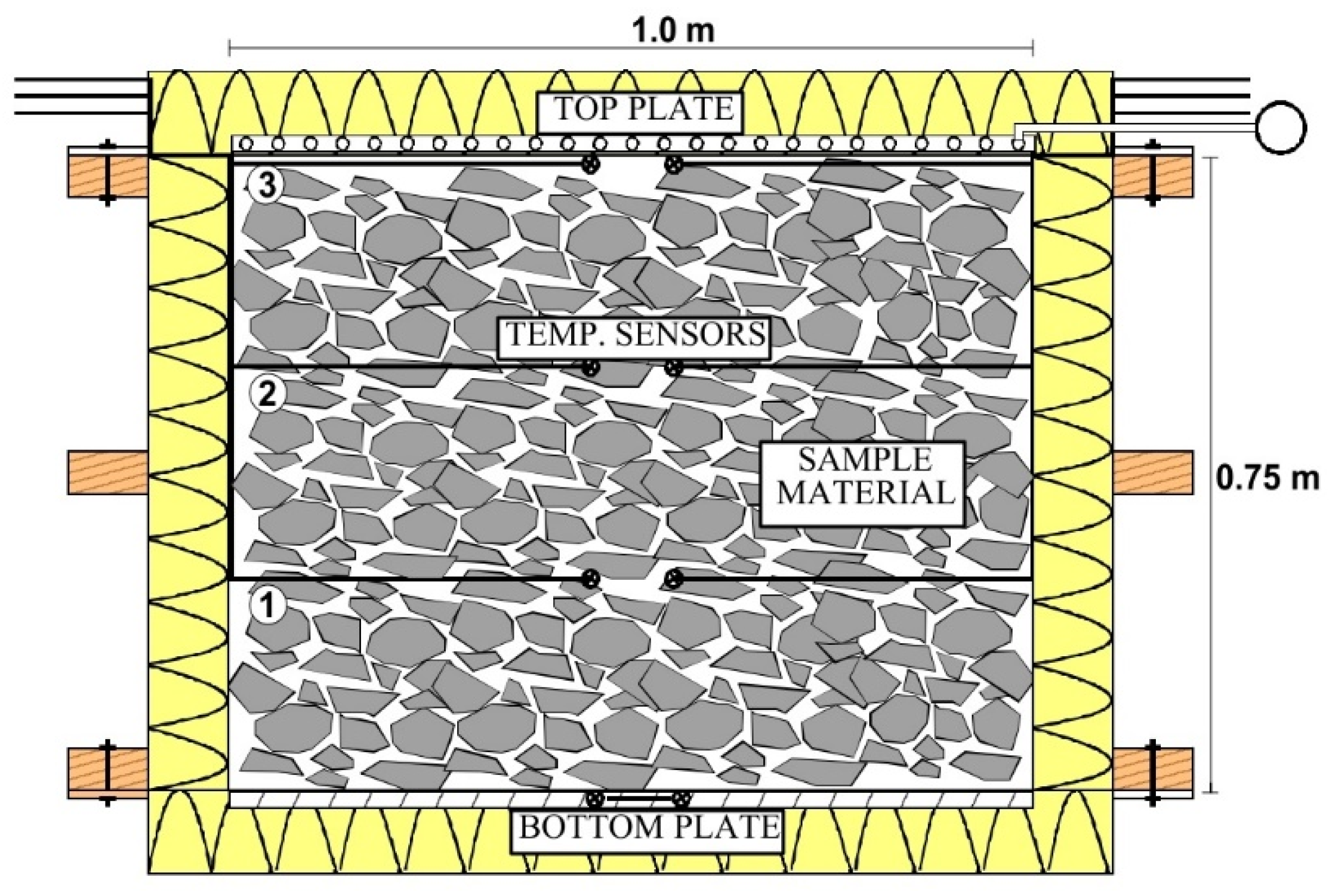
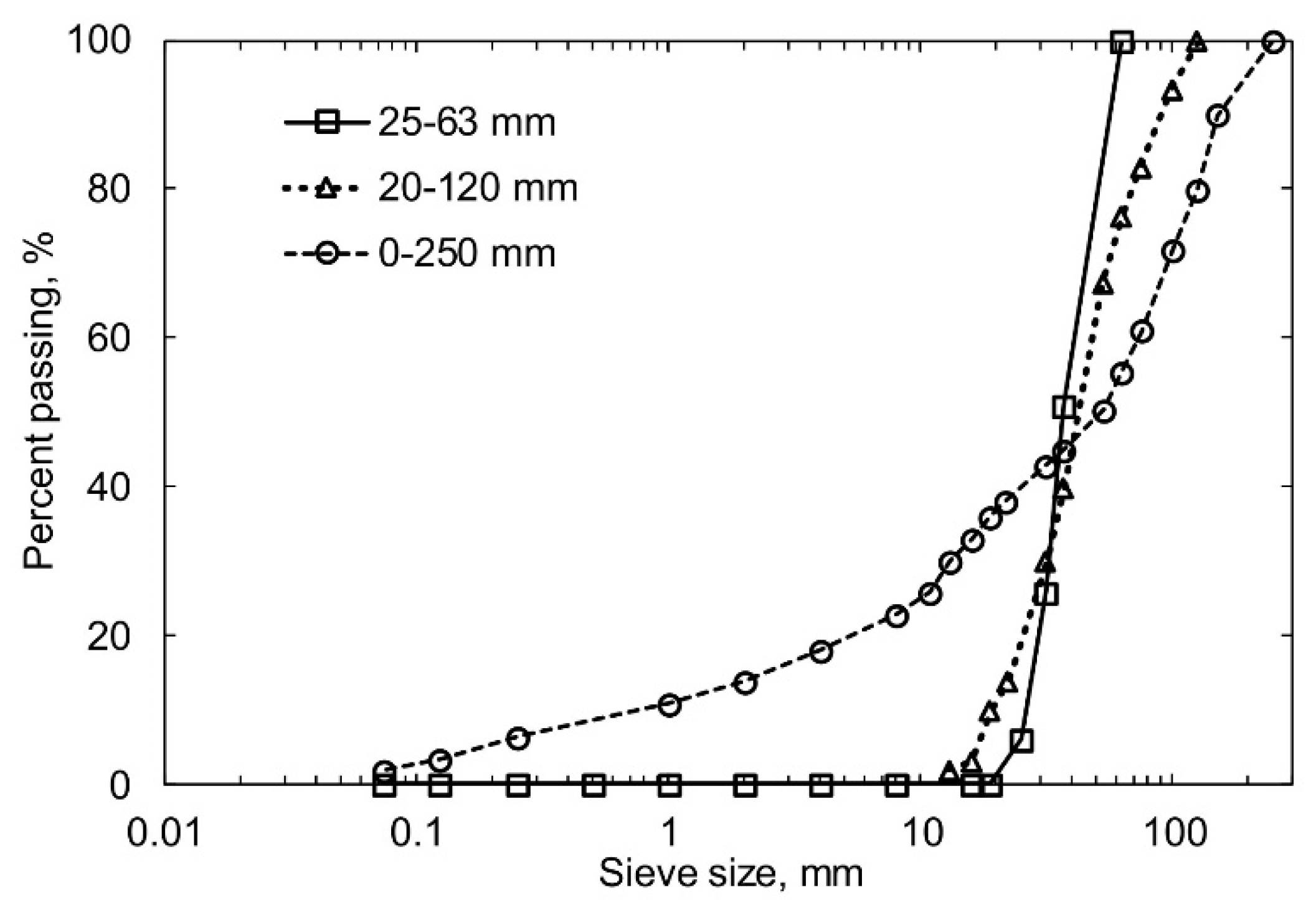
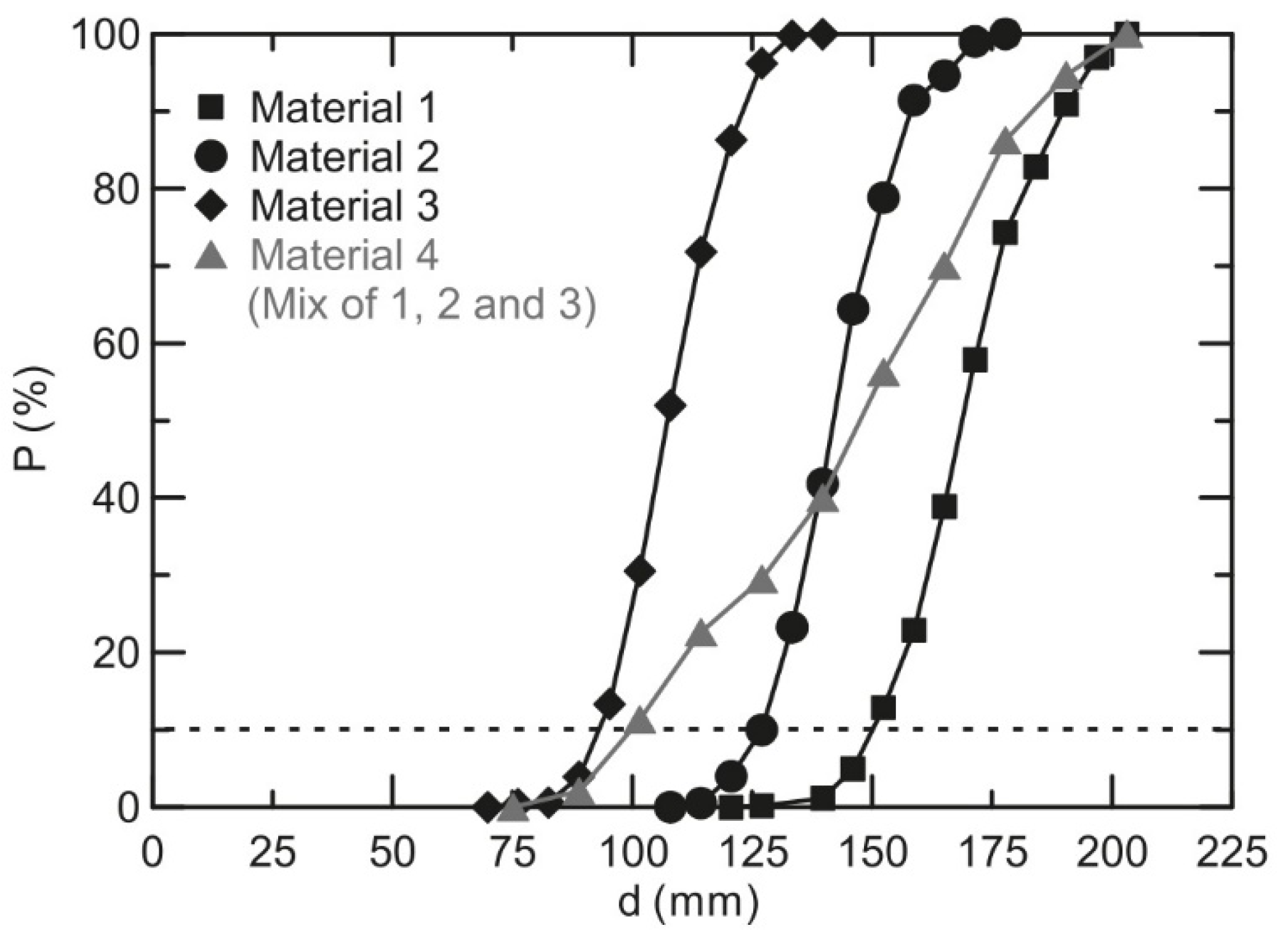
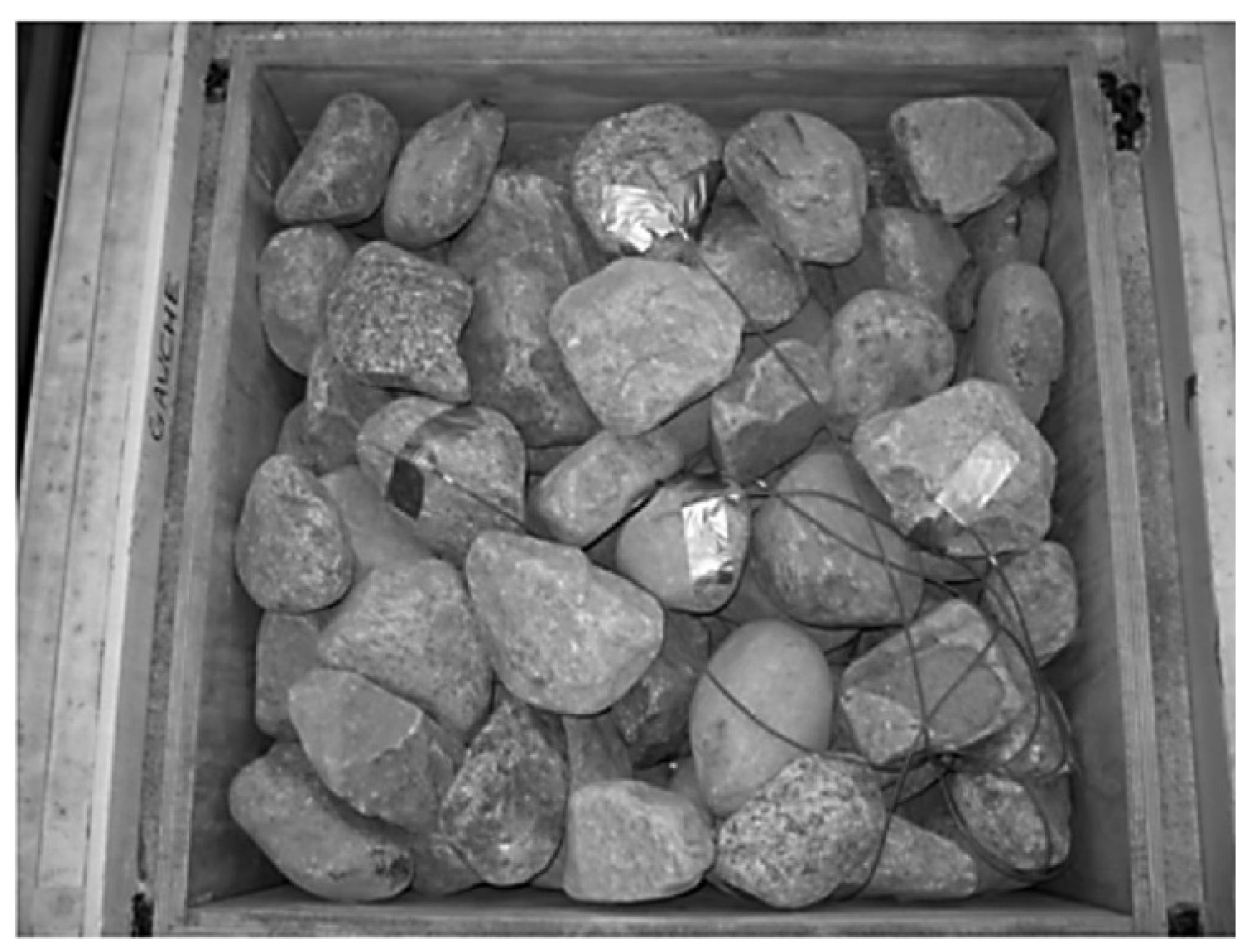
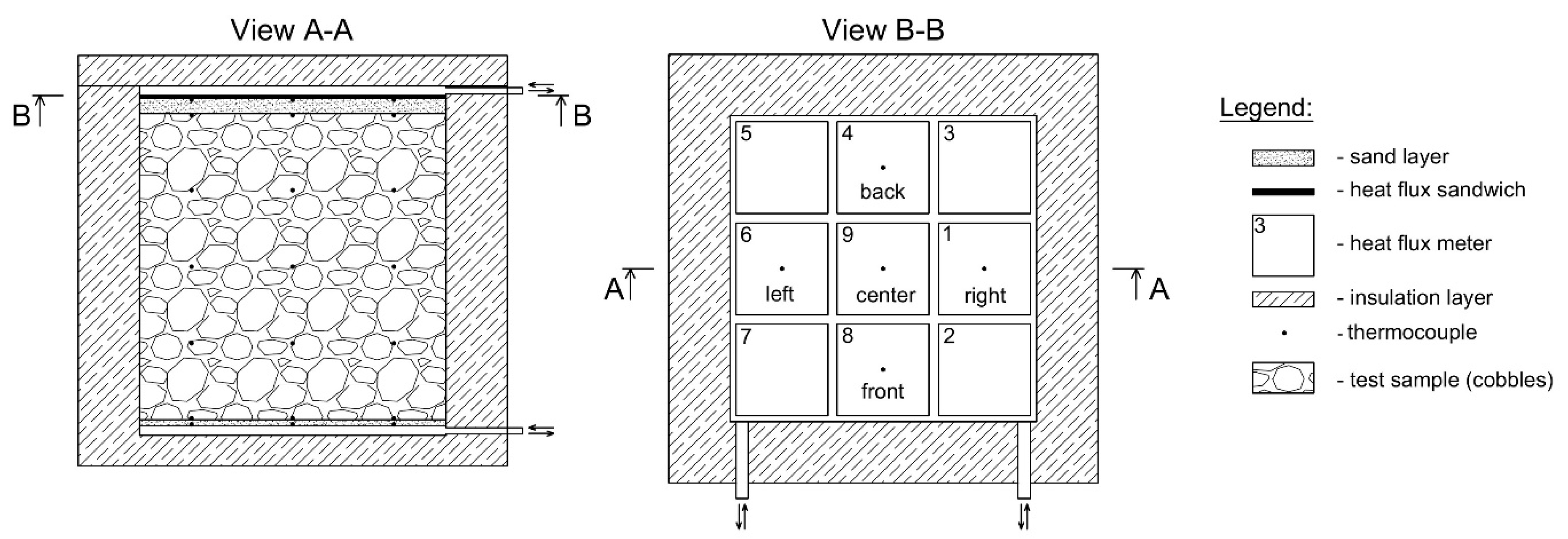


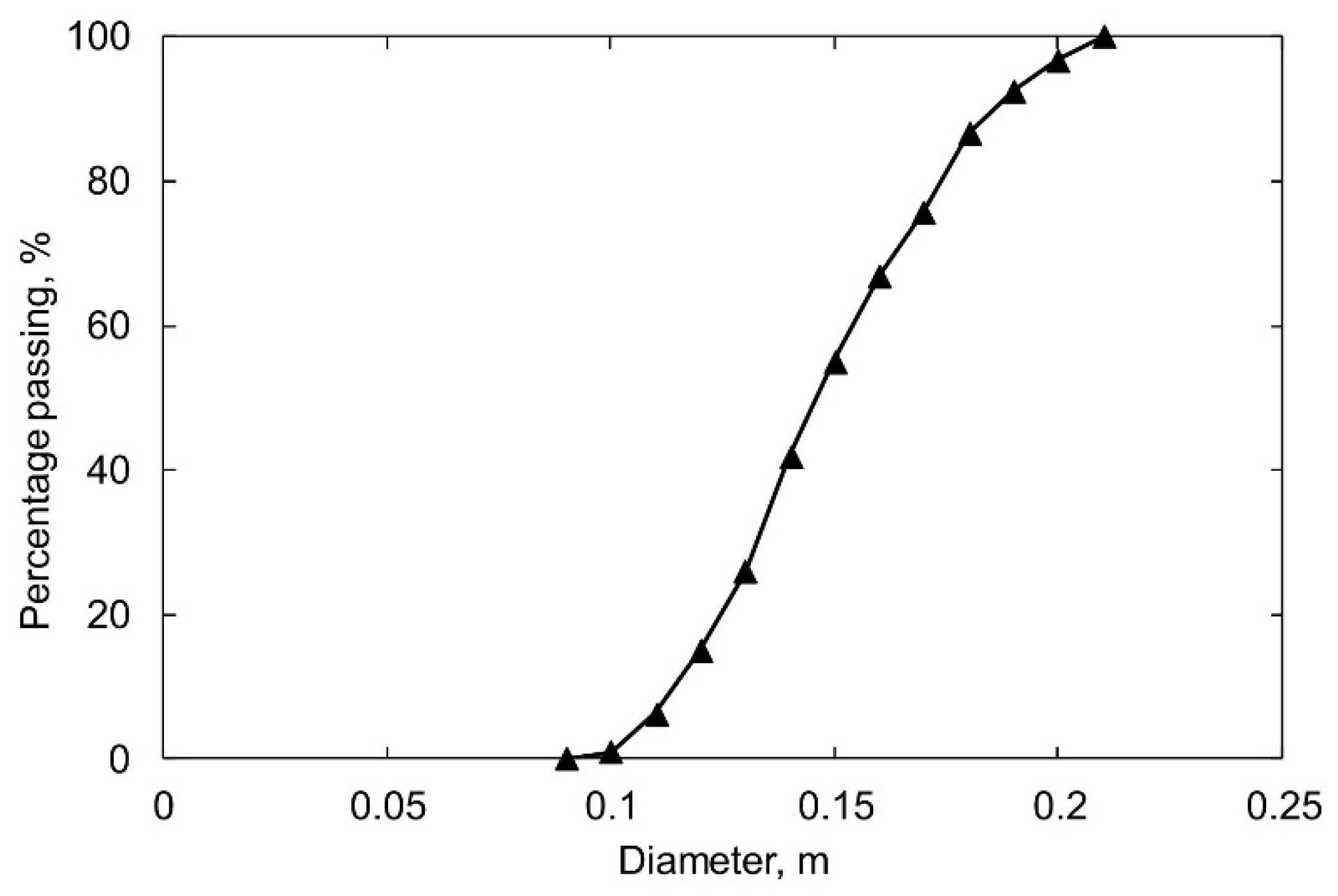
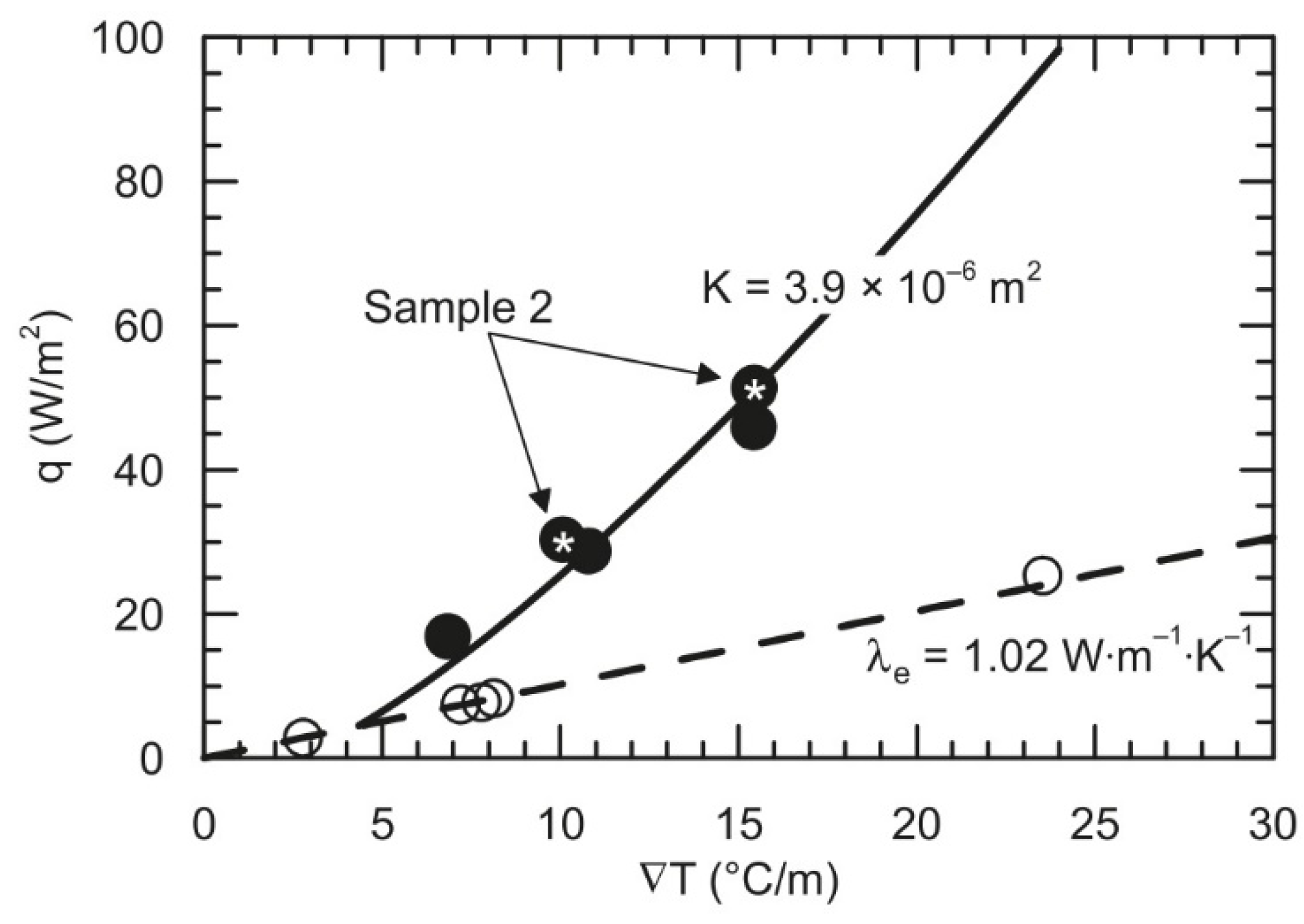
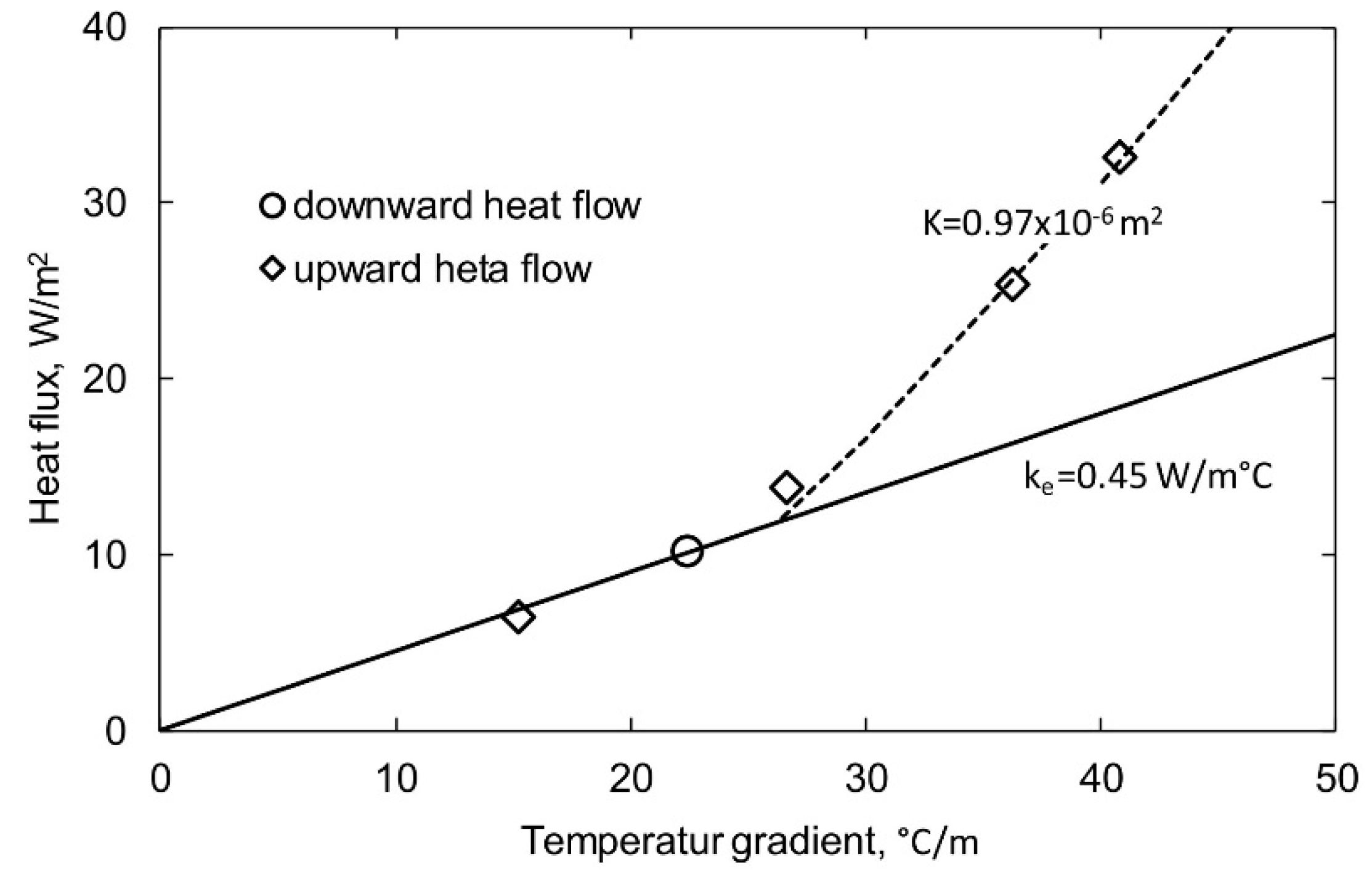
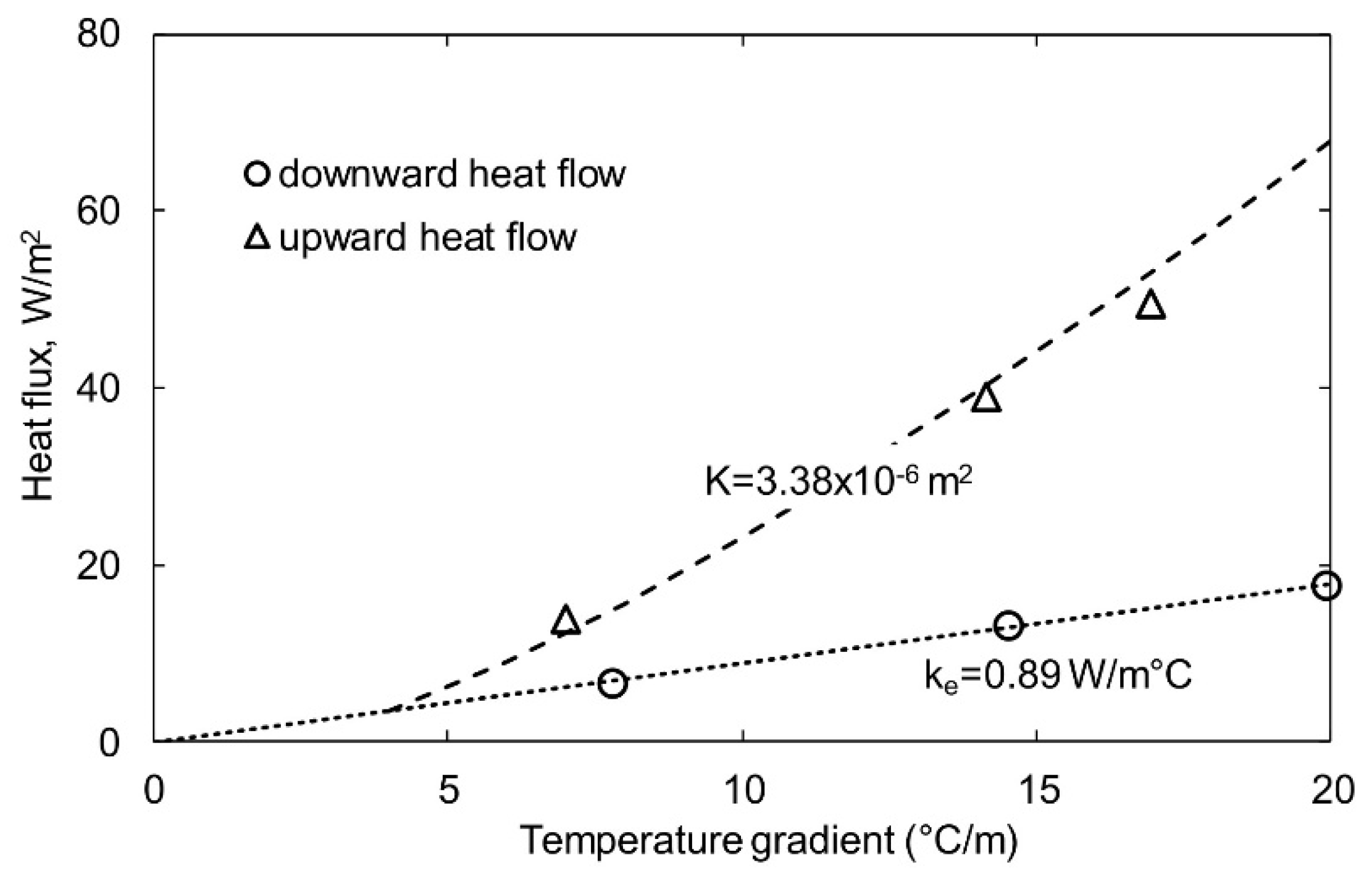



| Material | d10, mm | d50, mm |
|---|---|---|
| 25–63 mm | 26.2 | 36.8 |
| 20–120 mm | 19.0 | 42.2 |
| 0–250 mm | 0.7 | 53.1 |
| Johansen (1975) [2] | NGI (1999) [21] | Côté et al. (2011) [6] | Rieksts et al. (2017) [27] | |
|---|---|---|---|---|
| Sample width | 1.8 m | 1 m | 1 m | 1 m |
| Sample depth | 2.2 m | 1 m | 1 m | 1 m |
| Sample height | 0.48 m | 0.75 m | 0.94 m | 0.98 m |
| Boundary conditions | Temperature controlled on both sides | Heat flux controlled on warm side/temperature controlled on cold side | Temperature controlled on both sides | Temperature controlled on both sides |
| Heat flux measurements | Nine heat-flux gauges (size not specified) | Measurement of electrical current converted to heat flux | Four heat flux plates (each 0.4 × 0.4 m) covering 65% of sample surface | Nine heat flux plates (each 0.3 × 0.3 m) covering 90% of sample surface |
| Temperature measurements | Temperature sensors in layers with 22 sensors in each layer | Thermistors only along the centerline | Thermistors placed in layers with five sensors in each layer | Thermocouples placed in layers with five sensors in each layer |
| Material | n | d10, m | ke, W/m°C | K, m2 | |||
|---|---|---|---|---|---|---|---|
| 1 (sample 1) | 0.41 | 0.150 | 1.02 | 6.8 | 16.9 | 7.0 | 3.9 × 10−6 |
| 10.8 | 28.7 | 11.1 | |||||
| 15.4 | 45.9 | 15.9 | |||||
| 1 (sample 2) | 0.41 | 0.150 | 1.02 | 10.1 | 30.3 | 10.4 | |
| 15.4 | 51.4 | 15.9 | |||||
| 2 | 0.41 | 0.128 | 0.95 | 21.7 | 60.0 | 20.6 | 2.1 × 10−6 |
| 28.0 | 89.2 | 26.6 | |||||
| 3 | 0.39 | 0.092 | 0.71 | 25.3 | 53.0 | 17.9 | 1.5 × 10−6 |
| 4 | 0.37 | 0.100 | 0.83 | 24.5 | 77.6 | 20.3 | 2.9 × 10−6 |
| Material | n | d10, m | ke, W/m°C | K, m2 | |||
|---|---|---|---|---|---|---|---|
| 1 (sample 1) | 0.44 | 0.03 | 0.45 | 6.8 | 26.7 | 12.0 | 0.71 × 10−6 |
| 10.8 | 36.3 | 16.3 | |||||
| 15.4 | 40.8 | 18.4 |
| Material | n | d10, m | ke, W/m°C | K, m2 | |||
|---|---|---|---|---|---|---|---|
| Cobbles | 0.39 | 0.121 | 0.89 | 7.0 | 14.0 | 6.2 | 3.38 × 10−6 |
| 14.1 | 39.2 | 12.6 | |||||
| 17.0 | 49.7 | 15.1 | |||||
| Crushed rock 20–120 mm | 0.45 | 0.030 | 0.54 | 10.9 | 13.5 | 5.8 | 2.2 × 10−6 |
| 16.4 | 20.1 | 8.8 | |||||
| 21.3 | 36.4 | 11.4 | |||||
| Crushed rock | 0.45 | 0.038 | 0.59 | 9.0 | 14.0 | 5.1 | 1.1 × 10−6 |
| 40–120 mm | 17.8 | 34.5 | 10.6 | ||||
| Crushed rock 20–250 mm | 0.40 | 0.028 | 0.72 | 9.4 | 5.7 | 5.7 | 0.9 × 10−6 |
| 15.2 | 16.9 | 11.0 | |||||
| 19.9 | 29.8 | 14.5 |
| Material | n | d10, m | ke, W/m°C | K, m2 | |||
|---|---|---|---|---|---|---|---|
| 25–63 mm | 0.38 | 0.026 | 0.80 | 18.0 | 14.9 | 14.4 | 1.14 × 10−6 |
| 28.0 | 33.6 | 22.4 | |||||
| 30.7 | 41.4 | 24.6 | |||||
| 20–120 mm | 0.34 | 0.019 | 0.85 | 18.7 | 17.9 | 15.9 | 1.11 × 10−6 |
| 30.0 | 39.0 | 25.5 |
| Study | Material Type | Material Size, mm | d10, m | Porosity | K (× 10−6), m2 | |
|---|---|---|---|---|---|---|
| Côté et al. (2011) [6] | Cobbles | 120–200 | 0.150 | 0.41 | 4 | 3.90 |
| 110–155 | 0.128 | 0.41 | 7 | 2.10 | ||
| 70–140 | 0.092 | 0.39 | 8 | 1.50 | ||
| 75–200 | 0.100 | 0.37 | 5 | 2.90 | ||
| Rieksts et al. (2017) [27] | Cobbles | 90–210 | 0.121 | 0.39 | 4 | 3.38 |
| Rieksts et al. (2020) [31] | Crushed rock | 20–120 | 0.030 | 0.45 | 5 | 1.50 |
| 40–120 | 0.038 | 0.45 | 6 | 2.20 | ||
| 20–250 | 0.038 | 0.45 | 11 | 1.10 | ||
| Johansen (1975) [2] | Crushed rock | 20–80 | 0.030 | 0.44 | 26 | 0.71 |
| NGI (1999) [21] | Crushed rock | 25–63 | 0.026 | 0.38 | 20 | 1.14 |
| 20–120 | 0.019 | 0.34 | 19 | 1.11 |
| Study | Material Size, mm | ke, W/m°C Experimental | kc, W/m°C (Equation (4)) | kr, W/m°C (Equation (6)) | ke, W/m°C (Equation (3)) |
|---|---|---|---|---|---|
| Côté et al. (2011) [6] | 120–200 | 1.02 | 0.23 | 0.70 | 0.93 |
| 11–155 | 0.95 | 0.23 | 0.60 | 0.83 | |
| 70–140 | 0.71 | 0.25 | 0.43 | 0.68 | |
| 75–200 | 0.83 | 0.27 | 0.47 | 0.74 | |
| Rieksts et al. (2017) [27] | 90–210 | 0.89 | 0.25 | 0.57 | 0.82 |
| Rieksts et al. (2020) [31] | 20–120 | 0.54 | 0.34 | 0.11 | 0.45 |
| 40–120 | 0.59 | 0.34 | 0.18 | 0.52 | |
| 20–250 | 0.72 | 0.38 | 0.14 | 0.51 | |
| Johansen (1975) [2] | 20–80 | 0.45 | 0.34 | 0.10 | 0.44 |
| NGI (1999) [21] | 25–63 | 0.80 | 0.39 | 0.13 | 0.52 |
| 20–120 | 0.85 | 0.45 | 0.09 | 0.54 |
© 2020 by the authors. Licensee MDPI, Basel, Switzerland. This article is an open access article distributed under the terms and conditions of the Creative Commons Attribution (CC BY) license (http://creativecommons.org/licenses/by/4.0/).
Share and Cite
Rieksts, K.; Hoff, I.; Scibilia, E.; Côté, J. Establishment of Intrinsic Permeability of Coarse Open-Graded Materials: Review and Analysis of Existing Data from Natural Air Convection Tests. Minerals 2020, 10, 767. https://doi.org/10.3390/min10090767
Rieksts K, Hoff I, Scibilia E, Côté J. Establishment of Intrinsic Permeability of Coarse Open-Graded Materials: Review and Analysis of Existing Data from Natural Air Convection Tests. Minerals. 2020; 10(9):767. https://doi.org/10.3390/min10090767
Chicago/Turabian StyleRieksts, Karlis, Inge Hoff, Elena Scibilia, and Jean Côté. 2020. "Establishment of Intrinsic Permeability of Coarse Open-Graded Materials: Review and Analysis of Existing Data from Natural Air Convection Tests" Minerals 10, no. 9: 767. https://doi.org/10.3390/min10090767
APA StyleRieksts, K., Hoff, I., Scibilia, E., & Côté, J. (2020). Establishment of Intrinsic Permeability of Coarse Open-Graded Materials: Review and Analysis of Existing Data from Natural Air Convection Tests. Minerals, 10(9), 767. https://doi.org/10.3390/min10090767





